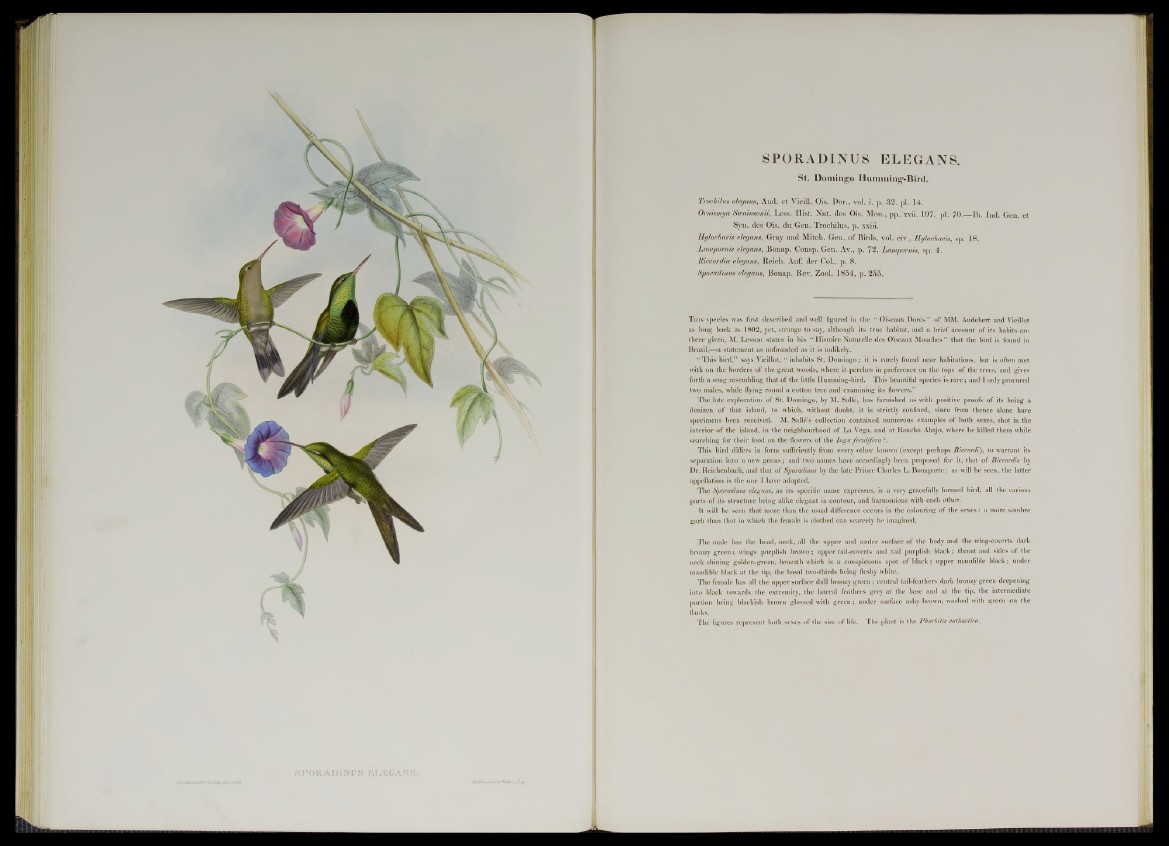
SPORADINUS ELEGANS.
St. Domingo Humming-Bird.
Trochilns elegans, Aud. e t Vieill. Ois. Dor., vol. i. p. 32. pi. 14.
Ch'nismya Swainsonii, Less. Hist. N at. des Ois. Mou., pp. xvii. 197. pi. 70.— lb . In d . Gen. et
Syn. des Ois. du Gen. Trochilus, p. xxiii.
Hylocharis elegans, Gray and Mitch. Gen. of Birds, vol. civ., Hylocharis, sp. 18.
Lampornis elegans, Bonap. Consp. Gen. Av., p. 72, Lampornis, sp. 4.
Riccordia elegans, Reich. Auf. der Col., p. 8.
Sporadinus elegans, Bonap. Rev. Zool. 1854, p. 255.
This species was first described and well figured in the “ Oiseaux Dores ” of MM. Audebert and Vieillot
as long back as 1802, yet, strange to say, although its true habitat, and a brief account of its habits are
there given, M. Lesson states in his “ Histoire Naturelle des Oiseaux Mouches ” that the bird is found in
Brazil,—a statement as unfounded as it is unlikely.
■“ This bird,” says Vieillot, “ inhabits St. Domingo; it is rarely found near habitations, but is often met
with on the borders of the great woods, where it perches in preference on the tops of the trees, and gives
forth a song resembling that of the little Humming-bird. This beautiful species is ra re ; and I only procured
two males, while flying round a cotton tree and examining its flowers.”
The late exploration of St. Domingo, by M. Salle, has furnished us with positive proofs of its being a
denizen of that island, to which, without doubt, it is strictly confined, since from thence alone have
specimens been received. M. Salle’s collection contained numerous examples of both sexes, shot in the
interior -of the island, in the neighbourhood of La Vega, and at Rancho Abajo, where he killed them while
searching for their food on the flowers of the Inga feculifera ?.
This bird differs in form sufficiently from every other known (except perhaps Riccordi), to warrant its
separation into a new genus 5 and two names have accordingly been proposed for it, that of Riccordia by
Dr. Reichenbach, and that of Sporadinus by the late Prince Charles L. Bonaparte: as will be seen, the latter
appellation is the one I have adopted.
The Sporadinus elegans, as its specific name expresses, is a very gracefully formed bird, all the various
parts of its structure being alike elegant in contour, and harmonious with each other.
It will be seen that more than the usual difference occurs in the colouring of the sexes : a more sombre
garb than that in which the female is clothed can scarcely be imagined.
The male has the head, neck, all the upper and under surface of the body and the wing-coverts dark
bronzy green; wings purplish brown; upper tail-coverts and tail purplish black; throat and sides of the
neck shining golden-green, beneath which is a conspicuous spot of black; upper mandible black; under
mandible black at the tip, the basal two-thirds being fleshy white.
The female has all the upper surface dull bronzy green ; central tail-feathers dark bronzy green deepening
into black towards the extremity, the lateral feathers grey at the base and at the tip, the intermediate
portion being blackish brown glossed with green; under surface ashy brown, washed with green ou the
flanks.
The figures represent both sexes of the size of life. The plant is the P/iarbitis cathartica.